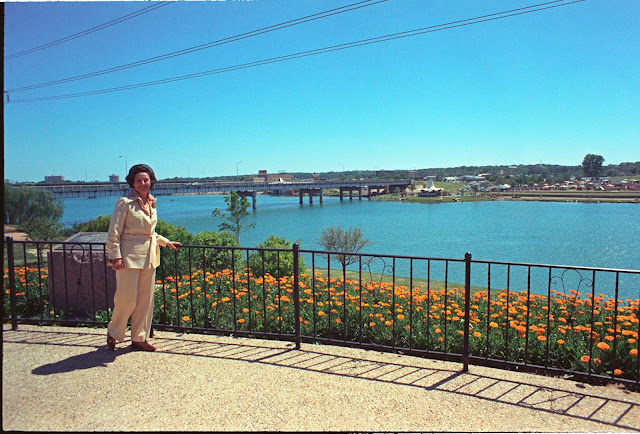 |
| Lady Bird Johnson at Town Lake |
Austin is situated on the Colorado River in Texas - not to be confused with the Colorado River that provides much of Southern California’s water. Dams along the river create a string of man-made lakes in the Austin area: Town Lake (renamed Lady Bird Lake in 2007), cliff-lined Lake Austin, and the largest, Lake Travis to the west. I would jog around Town Lake which had been “beautified” by Lady Bird Johnson’s campaign in 1970’s to improve the city’s riverfront. People would mimic Lady Bird’s Texas drawl and say “plant a booish, flar, shruub or tree – too-day”. In spring and early summer I would count the varieties of blooming wildflowers that had been planted on the north side of the lake, often losing count somewhere in the high 40s. The show was spectacular. Today the trail and wildflowers are maintained by the Trail Foundation.
 |
| Bats at the Congress Street Bridge |
To get to the north trail I’d cross the river on the Lamar Street Bridge. The newly completed cyclist and pedestrian Pfluger Bridge allows for much safer crossing. Further south on the lake is the Congress Street Bridge. At an estimated 1.5 million the bridge is home to largest urban population of Mexican free-tail bats in North America---did I mention there are a lot of bugs in Austin?
On my jogs I would cross back over the river on the pedestrian bridge that runs under the MoPac freeway. Lining the south bank of the river is a stand of 100+ year old native cypress, cottonwoods, and pecan trees. Several of the cypress trees where the tallest trees I’d ever seen in Central Texas.
Town Lake and upstream Lake Austin have significant problems with a water plant introduced by the aquarium trade, Hydrilla verticillata. Hydrilla is native to parts of Asia, Africa, and Australia and can grow up to 25 feet in clear water. It has few pests and chokes out native species, creating large monocultures. In the 70’s in the late fall Lake Austin would be drained in hopes that a cold winter would kill the hyrdrilla, or at least control it. The good news is that due to the recent drought a local native water plant, cobamba has been able to out compete hydrilla in Town Lake.
On the south side of the lake is the 350 acre Zilker Park. The trail on this side of the lake is much higher above the lake. After crossing the bridge, there is a large lotus pond. People would stand at the edges and count the water moccasins (venomous snakes) that had staked out a sunny spot on top of the lotus leaves.
 |
| Japanese Garden in Zilker Park |
Tw0 notable attractions in the park are the Zilker Botanical Garden and Barton Springs. The 32 acre garden was the first botanical garden I had ever been in. Unusual for Texas, it includes the Isamu Taniguchi Japanese Garden. It is situated on steep hillside with 2 large koi ponds, connected by limestone lined rivulets, a Moon Bridge, teahouse and other traditional Japanese garden features. This was my first introduction to Japanese gardens.
Back on the path around the lake, I’d cross the bridge over where Barton Springs meets Town Lake; large turtles are everywhere sunning themselves on the rocks and fallen trees. Barton Springs in comprised of 4 springs where the Balcones fault cuts into the Edwards Aquifer. The large limestone caverns of Texas produce one of the most prolific artesian aquifers in the world. Cool and clear fast-running springs dot the area between Austin and San Antonio. Aquarena Springs, the Comal river, Barton Springs and several other springs are popular attractions for escaping the long hot & humid Texas summer. Central Texas creeks and rivers are popular for “tubing”- a day long float down a cold river in an oversized inner tube accompanied by friends and a beer-filled ice chest. Barton Springs is one of the most urban springs and had been channeled into a manmade pool about the length of 3 football fields (Texans measure things by football fields.). The springs produce on average 31 million gallons of 68 degree water per day. The best way to enter is a head first dive that takes your breath away as your body tries to adjust to abrupt change from 90+ degree air. If the cool water isn’t enough to draw visitors, the pool is also popular with topless sunbathing young women and their admirers. I spent many a hot summer day floating on a raft in the middle of the pool and now have the skin cancers to prove it.
 |
Spring fed, 68 degree Barton Springs |